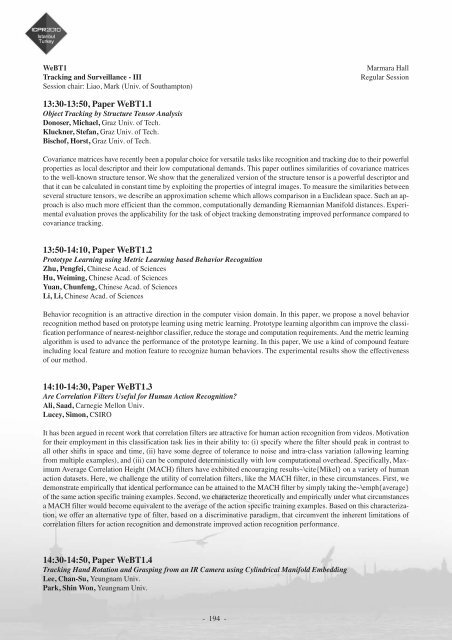Abstract book (pdf) - ICPR 2010
Abstract book (pdf) - ICPR 2010
Abstract book (pdf) - ICPR 2010
- TAGS
- abstract
- icpr
- icpr2010.org
You also want an ePaper? Increase the reach of your titles
YUMPU automatically turns print PDFs into web optimized ePapers that Google loves.
WeBT1 Marmara Hall<br />
Tracking and Surveillance - III Regular Session<br />
Session chair: Liao, Mark (Univ. of Southampton)<br />
13:30-13:50, Paper WeBT1.1<br />
Object Tracking by Structure Tensor Analysis<br />
Donoser, Michael, Graz Univ. of Tech.<br />
Kluckner, Stefan, Graz Univ. of Tech.<br />
Bischof, Horst, Graz Univ. of Tech.<br />
Covariance matrices have recently been a popular choice for versatile tasks like recognition and tracking due to their powerful<br />
properties as local descriptor and their low computational demands. This paper outlines similarities of covariance matrices<br />
to the well-known structure tensor. We show that the generalized version of the structure tensor is a powerful descriptor and<br />
that it can be calculated in constant time by exploiting the properties of integral images. To measure the similarities between<br />
several structure tensors, we describe an approximation scheme which allows comparison in a Euclidean space. Such an approach<br />
is also much more efficient than the common, computationally demanding Riemannian Manifold distances. Experimental<br />
evaluation proves the applicability for the task of object tracking demonstrating improved performance compared to<br />
covariance tracking.<br />
13:50-14:10, Paper WeBT1.2<br />
Prototype Learning using Metric Learning based Behavior Recognition<br />
Zhu, Pengfei, Chinese Acad. of Sciences<br />
Hu, Weiming, Chinese Acad. of Sciences<br />
Yuan, Chunfeng, Chinese Acad. of Sciences<br />
Li, Li, Chinese Acad. of Sciences<br />
Behavior recognition is an attractive direction in the computer vision domain. In this paper, we propose a novel behavior<br />
recognition method based on prototype learning using metric learning. Prototype learning algorithm can improve the classification<br />
performance of nearest-neighbor classifier, reduce the storage and computation requirements. And the metric learning<br />
algorithm is used to advance the performance of the prototype learning. In this paper, We use a kind of compound feature<br />
including local feature and motion feature to recognize human behaviors. The experimental results show the effectiveness<br />
of our method.<br />
14:10-14:30, Paper WeBT1.3<br />
Are Correlation Filters Useful for Human Action Recognition?<br />
Ali, Saad, Carnegie Mellon Univ.<br />
Lucey, Simon, CSIRO<br />
It has been argued in recent work that correlation filters are attractive for human action recognition from videos. Motivation<br />
for their employment in this classification task lies in their ability to: (i) specify where the filter should peak in contrast to<br />
all other shifts in space and time, (ii) have some degree of tolerance to noise and intra-class variation (allowing learning<br />
from multiple examples), and (iii) can be computed deterministically with low computational overhead. Specifically, Maximum<br />
Average Correlation Height (MACH) filters have exhibited encouraging results~\cite{Mikel} on a variety of human<br />
action datasets. Here, we challenge the utility of correlation filters, like the MACH filter, in these circumstances. First, we<br />
demonstrate empirically that identical performance can be attained to the MACH filter by simply taking the~\emph{average}<br />
of the same action specific training examples. Second, we characterize theoretically and empirically under what circumstances<br />
a MACH filter would become equivalent to the average of the action specific training examples. Based on this characterization,<br />
we offer an alternative type of filter, based on a discriminative paradigm, that circumvent the inherent limitations of<br />
correlation filters for action recognition and demonstrate improved action recognition performance.<br />
14:30-14:50, Paper WeBT1.4<br />
Tracking Hand Rotation and Grasping from an IR Camera using Cylindrical Manifold Embedding<br />
Lee, Chan-Su, Yeungnam Univ.<br />
Park, Shin Won, Yeungnam Univ.<br />
- 194 -



